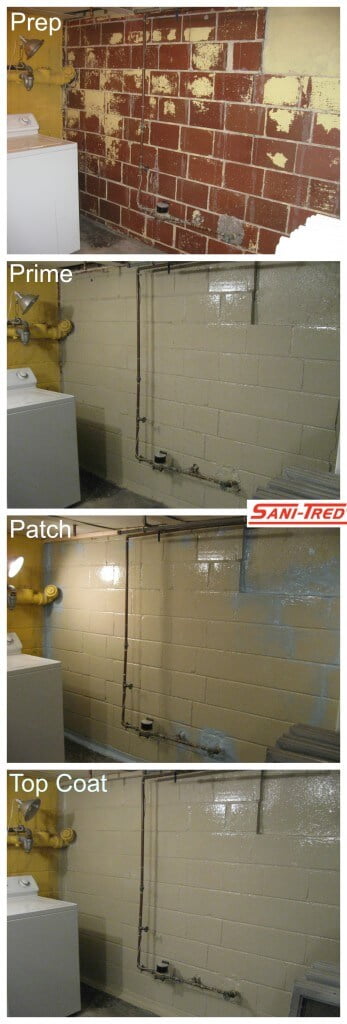
To understand how to seal basement floor from water or how to be successful at indoor basement waterproofing, we need to start with a little history engineering basics and on how to seal concrete basement floor. A liquid applied indoor coating for wine cellars, rock tunnels or basement waterproofing that is both permanent and provides a reliable waterproof and vapor-proof seal has been a dream of designers, architects and builders for thousands of years and is commonly referred to in the trades as “tanking”.
Successful tanking is such a demanding job to do successfully and dependably that in professional circles most designers, engineers and architects assume and are trained to believe it to be an impossible task for any coating. The reason for this is that before the invention of SANI-TRED, there was no other materials in the world that have ever been produced that has even been close to having the minimum required qualities to handle the special obstacles that face a coating that is used for tanking.
Virtually all other coating or sealing products that are being marketed and sold deceptively to the unsuspecting public for indoor basement waterproofing are not capable of performing this difficult task on their best day.
Bare Minimum Qualities for Successful Indoor Tanking
- Must be completely waterproof not just water resistant.
- Must be capable of retaining great amounts of negative hydrostatic pressure and moisture vapor drive forces.
- Must be strong enough to be applied to sealing concrete basement floors and withstand heavy traffic.
- Must remain permanently flexible without hardening.
- Must weld to itself new to old without rejection.
- Must be low-odor or odor-free, or solvent- free for indoor use.
- Must be non-toxic, non-hazardous, non-flammable.
- Must have excellent adhesive qualities.
- Must have viscosity control to seal large cracks and joints.
- Must be permanent not just a temporary maintenance product like paint or caulk.
Reasons for Tanking Failure
The most important reason for tanking failure that has barred all other coatings is the inability to retain normally insurmountable natural forces of underground water pressure that can penetrate basement walls/floors.
Moisture vapor creates a build-up of pressure under a coating, causing blisters or delamination when this high pressure humidity seeps through concrete floors (moisture vapor drive). Some moisture vapor drive in deep underground basement floor surfaces has been measured at 30psi or more! That’s almost the same amount of pressure in your car tires underneath the coating trying to push it off of the concrete.
Another important force that has prevented successful tanking is foundation settling and crack forming caused by settling. To survive this great force, any sealing product that is used for tanking must produce an extremely strong adhesive bond to the concrete.
Next it must provide the viscosity thickness to fill and seal wide cracks and seams in concrete surfaces and maintain permanent flexibility.
It takes a very special set of circumstances just to start to be successful at indoor basement waterproofing (and we’re not finished with what it REALLY takes to be successful at this most demanding and difficult task for any coating or sealing material).
Another fact that has prevented successful tanking is that no matter how perfect one tries to apply a uniform liquid applied coating, the person doing the application may miss a spot or two and leave minor imperfections in one or more applications.
This brings us to a rarely known fact
All other coatings, sealers etc. in the world, form distinct separations between applications or coating layers called “cold joints”. These cold joints vary in degree from a minor weakness between coats to complete rejection and immediate separation or “pealing” between multiple coat layers.
SANI-TRED is the only liquid applied coating of any kind that molecularly bonds to itself old to new at any age or stage of cure. This extremely important unique quality allows SANI-TRED to be applied in an extremely simple and efficient, system of liquid smooth wall coatings along with paste-like joint sealing materials that all cures as one solid unified and permanently bonded rubber liner to all concrete surfaces.
Amazing breakthrough in chemical science
The cured strength, penetration capabilities, permanent cured flexibility, adhesive strength as well as other unique qualities allows SANI-TRED waterproofing products to easily do normally impossible tasks like seal basement floors made from concrete. SANI-TRED can do these things and have cured properties that are many times stronger or better than required minimums to perform the task
This is what makes SANI-TRED “fool-proof” and why it’s considered easy to use to seal your basement floor from moisture. Even if an amateur makes mistakes during a do-it-yourself application and does not install the products correctly, SANI-TRED is forgiving due to its overkill qualities.
